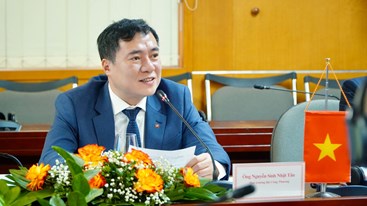Sunday, 05/05/2024 | 09:02 GMT+7
Statistics show that Vietnam currently has 65 steel production plants, each having an annual output of 100,000 tonnes or more. Though most of these plants operate at less than 50 percent of their designed capacity, they consume as much as 3.5 billion kWh of electricity each year. To meet the domestic demand, the electricity sector has invested about VND35.5 trillion in power sources, power stations and power transmission lines.
Some developed countries such as Japan consume only 350-400kWh of electricity to make every tonne of steel billets whereas Vietnam consumes as much as 700kWh of electricity to do that. So if it does not take actions to reduce energy consumption in order to lower the production cost, the Vietnamese steel sector can hardly withstand market competition.
Efforts to reduce costs
In the past two years, under the pressure of rising raw material and fuel prices together with the adverse impacts of the global financial crisis, the domestic steel sector encountered numerous difficulties. In such circumstances, in order to improve their competitiveness, steel companies have become more active in seeking solutions to reduce production costs, and one of the solutions is to apply energy conservation methods.

Phan Manh Hung, the deputy director of the Thai Nguyen Iron and Steel Factory, said, “In an effort to minimize power consumption, our factory has reduced the amount of time in which machines are at the standby or non-operation status. The factory has also replaced all incandescent bulbs of the lighting system with compact lamps to save power. To put power consumption under tight control, the factory has set clear norms for material and fuel consumption, which must be followed by all production units.”
In November 2009, the Pomina Steel Factory began to apply the Consteel technology in steel refining and the Siemens-VAI technology in steel rolling. These technologies have allowed Pomina to reduce the expenditure on power consumption by 30 percent, thus lowering production costs by more than US$10 per tonne. In addition, the process of making hot rolled steel billets is loaded directly from the refining factory, reducing reheating costs in the process of steel rolling by 30 percent.
In 2009, the Vietnam-Australia Steel Production Joint-venture Company began to use steel furnaces with modern technology of Chinese Taipei with an aim to increase productivity and reduce energy consumption. The company also upgraded the heat recovery equipment and began to use inverters and power saving lamps. In addition, the company decided not to roll steel during peak hours to minimize the expenditure on power consumption. These solutions have allowed the company to reduce power consumption by 20 percent compared with the past.
To support steel businesses’ efforts to save power through technological innovation, in 2008, under the National Program on Energy Efficiency and Conservation, the Vietnam Academy of Science and Technology was assigned to assist major companies of the metallurgy sector of localities in applying energy conservation methods.
In the past two years, seven steel companies have been selected to undergo an energy audit to be provided with consultancy and financial support to apply energy conservation methods. Taking the solutions proposed by the auditors, many companies have invested in technological innovation to upgrade the production line, and they have gained good initial results. For example, since they began to apply energy conservation methods, four steel plants in Bac Ninh Province have been able to save 133,000kWh of electricity, 112 tonnes of coal and 81 tonnes of firewood each year. Energy conservation methods have also helped reduce carbon dioxide (CO2) emissions by 115 tonnes each year.
Investments needed
In the opinion of experts, many steel plants throughout the country have begun to apply energy conservation methods. Simple solutions such as improving the lighting system and establishing a specialized team responsible for managing energy consumption can be taken easily with low investment. However, many companies remain unwilling to invest large amounts of money in applying advanced technologies to improve production, for example the Consteel technology that is widely applied in many other countries.
Tran Manh Hung from
the Energy Institute of the Ministry of Industry and Trade said that in Vietnam
the application of advanced technologies in steel production is still limited
because most steel plants in Vietnam have a capacity of less than 300 tonnes.
He analyzed that the Consteel technology is power saving but requires much
investment capital, US$300 million for a steel furnace with capacity of 500,000
tonnes per year. So most domestic steel producers cannot afford to apply this
technology. However, in the opinion of experts, it is urgently necessary for
steel businesses to invest in clean, power saving technologies.
By Thuy Tien



.png?w=367&h=206&mode=crop)




.jpg?w=367&h=206&mode=crop) Energy efficiency and conservation usage is an important aspect of the national energy development strategy
05/03/2024
Energy efficiency and conservation usage is an important aspect of the national energy development strategy
05/03/2024
 Challenges and Opportunities to promote energy efficiency market in Vietnam
Challenges and Opportunities to promote energy efficiency market in Vietnam
 The Ministry of Industry and Trade requests government agencies to coordinate in organizing Earth Hour 2024
The Ministry of Industry and Trade requests government agencies to coordinate in organizing Earth Hour 2024
 Consultation on Energy Efficiency Boiler Catalogue and Wood Drying Guideline
Consultation on Energy Efficiency Boiler Catalogue and Wood Drying Guideline
 Son Ha Co., Ltd, applies energy efficiency and conservation measures
Son Ha Co., Ltd, applies energy efficiency and conservation measures
.png?w=367&h=206&mode=crop) Request for expression of interest - C2.1.13: Capacity Building on energy efficiency policies development
Request for expression of interest - C2.1.13: Capacity Building on energy efficiency policies development
 Phuc Kien Co., Ltd., is effectively implementing energy-saving measures
Phuc Kien Co., Ltd., is effectively implementing energy-saving measures
 Request for expression of interest - C2.1.12: Independent monitoring of safeguards implementation
Request for expression of interest - C2.1.12: Independent monitoring of safeguards implementation